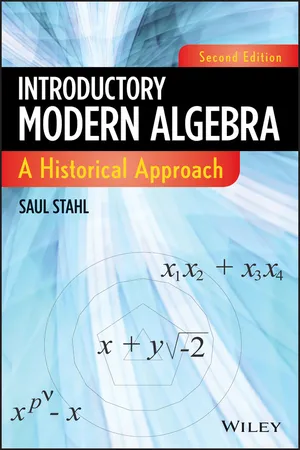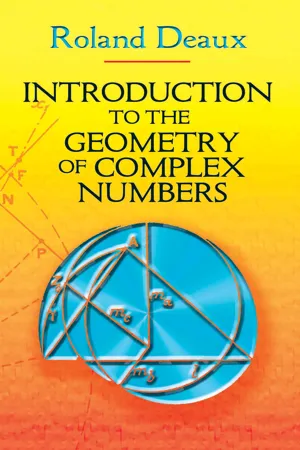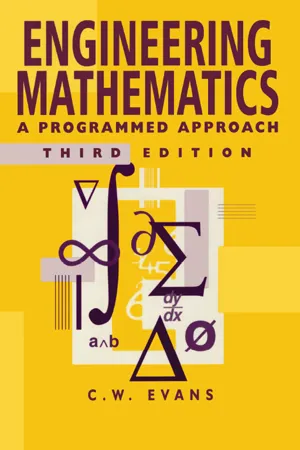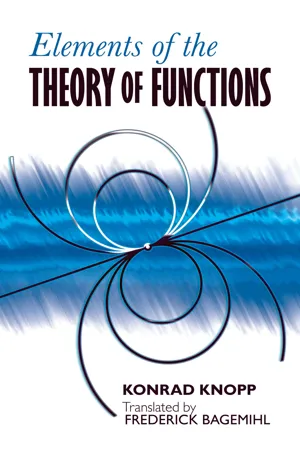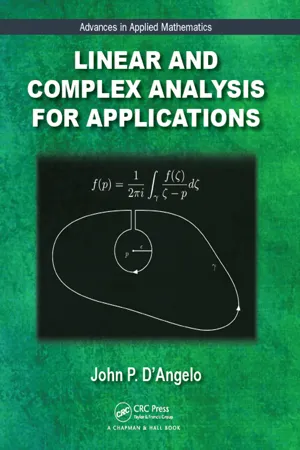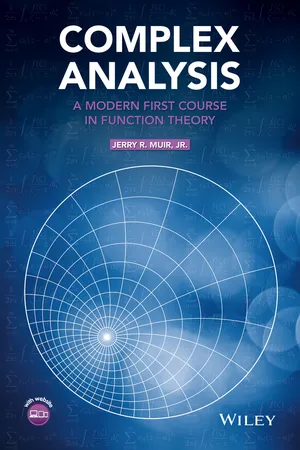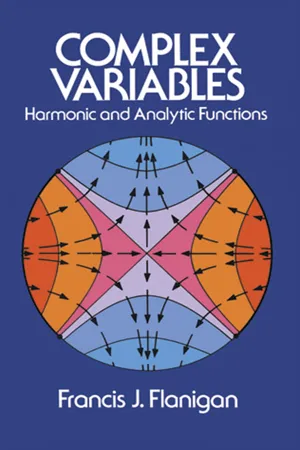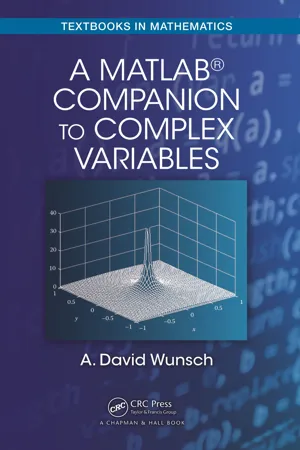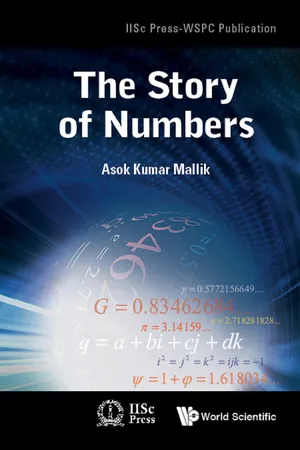Mathematics
Representation of Complex Numbers
Complex numbers can be represented in two main forms: rectangular form and polar form. In rectangular form, a complex number is represented as a sum of a real part and an imaginary part, while in polar form, it is represented using its magnitude and argument. These representations are useful for performing operations and understanding the geometric properties of complex numbers.
Written by Perlego with AI-assistance
Related key terms
Related key terms
1 of 4
Related key terms
1 of 3
11 Key excerpts on "Representation of Complex Numbers"
- eBook - ePub
Introductory Modern Algebra
A Historical Approach
- Saul Stahl(Author)
- 2013(Publication Date)
- Wiley(Publisher)
real. These complex numbers can be added and subtracted as polynomials. Thus,The multiplication of complex numbers also resembles that of polynomials, except that each occurrence of i2 is replaced by −1. Thus,The division of complex numbers mimics the well-known process of rationalizing denominators. Thus,Surprisingly, all of these arithmetical operations can be given very interesting visual, or geometric, interpretations. To accomplish this, we represent each complex number a + bi by the point (a, b) of the Cartesian plane. The point (a, b) is called the Cartesian representation of the complex number a + bi. Given two complex numbers a + bi and c + di, let their Cartesian representations be P = (a, b) and Q = (c, d) (Figure 2.1 ). Their sumFigure 2.1Complex additionis represented by the point R = (a + c, b + d). However,andConsequently, PR || OQ and QR || OP and so OPRQ is a parallelogram. Thus we see that the addition of complex numbers resembles that of vectors. These considerations are summarized as follows.Proposition 2.1 Let O denote the origin of the Cartesian plane and let P and Q be the Cartesian representations of the complex numbers a + bi and c + di, respectively. If the sum of the two complex numbers is represented by the point R, then the quadrilateral OPRQ is a parallelogram.To give the multiplication of complex numbers a visual interpretation, it is convenient to begin by establishing some conventions. In the sequel, the general complex number a + bi will frequently be abbreviated as z. If either a or b is 0, it is omitted from a + b - eBook - ePub
- Roland Deaux, Howard Eves, Howard Eves(Authors)
- 2013(Publication Date)
- Dover Publications(Publisher)
CHAPTER ONEGEOMETRIC Representation of Complex Numbers
I. FUNDAMENTAL OPERATIONS
1. Complex coordinate. Consider the complex numberx + iy (x and y real)which we denote by z. Draw, in a plane, two perpendicular coordinate axes Ox , Oy . The point Z having for abscissa the real part x of the number z and for ordinate the coefficient y of i is called the representative point, or the image, of the number z. Conversely, each real point Z1 , of the plane is the image of a unique complex number z 1 equal to the abscissa of Z1 increased by the product with i of the ordinate of this point. The number z 1 is called the complex coordinate, or the affix, of the point Z1 .A plane in which each real point is considered as the image of a complex number is called the Gauss plane, the Cauchy plane, or the plane of the complex variable.We shall denote a point of the Gauss plane by an upper case letter, and its affix by the corresponding lower case letter.Corollaries. 1° The Ox axis is the locus of the images of the real numbers. The Oy axis is the locus of the images of the pure imaginary numbers. This is why Ox and Oy are sometimes called the real axis and the imaginary axis of the Gauss plane.2° The number— z is the affix of the symmetric of point Z with respect to the origin O.2. Conjugate coordinates. The complex number conjugate toz = x + iy will be designated by the notation z = x – iywhich is read, “ z bar,” and which will never appear as the written representation of a vector. A vector will always be indicated by the juxtaposition of the two upper case letters representing its origin and its extremity, surmounted by a bar, as .The imageof the number is the point symmetric to Z with respect to theOx axis.3. Exponential form. In the Gauss plane, we choose for the positive sense of rotation and of angles the sense of the smallest rotation about O which carries the Ox axis into the Oy axis. The algebraic value (x y ) of any angle having Ox for initial side and Oy for terminal side is, then, to within an integral multiple of 2π - eBook - ePub
Engineering Mathematics
A Programmed Approach, 3th Edition
- C W. Evans(Author)
- 2019(Publication Date)
- Routledge(Publisher)
Chapter 3 ).To each complex number a + ib there is a unique point (a, b) in the plane Oxy. Conversely, given any point (a, b) in the plane Oxy, there is a unique complex number a + ib. There is therefore a one-to-one correspondence between the points in the plane Oxy and the complex numbers (Fig. 10.1 ).When the plane is used in this way it is often called an Argand diagram or the complex plane. The x-axis is then called the real axis and the y-axis is called the imaginary axis.POLAR FORMOf course we know that a point in the plane can be expressed in polar coordinates rather than in cartesian coordinates (Fig. 10.2 ). We obtain from elementary trigonometrya = r cos θ , b = r sin θso thata + i b = r cos θ + i r sin θ= r(cos θ + i sin θ)Fig. 10.1 Cartesian coordinates.Fig. 10.2 Polar coordinates.When a complex number is expressed in this way, we say it is expressed in polar form.The easiest way to express a complex number in polar form is to put the complex number on the Argand diagram using the correspondence a + ib → (a, b), and then to read off the distance r = √(a2 + b2 ) and the angle θ.MODULUS AND ARGUMENTThe usual convention for polar coordinates is to take r > 0 and 0 ⩽ θ < 2π, so that a unique representation is obtained for every point other than the origin.In the complex plane, the convention is slightly different. Here we take r > 0, as before, but −π > θ ⩽ π. r is known as the modulus of the complex number: r = √(a2 + b2 ). θ is known as the argument of the complex number: θ = tan−1 (y/x) when θ ∈ (−π/2, π/2).It follows that any non-zero complex number can be represented uniquely by the modulus r and the argument θ. The notation r∠θ is often used to denote these essential ingredients. When a complex number is expressed in polar form where θ is the argument of the complex number, so that −π < θ ⩽ π, it is said to be in modulus-argument form - eBook - ePub
- Konrad Knopp, Bagemihl, Frederick, Bagemihl, Frederick(Authors)
- 2016(Publication Date)
- Dover Publications(Publisher)
23 then we can writeand this representation is obviously fully unique. Finally, according to §8 ,and soThus, our new number system contains numbers whose squares are real and negative;—and likewise, as it will turn out, all the remaining “impossibilities” mentioned in §4 have now turned into realities. In this sense, then, it constitutes a consistent extension of the system of real numbers, and, indeed, one which no longer possesses the deficiencies of the latter.Since every complex number a = (α, α′) can be represented in the formthe operations with complex numbers can also be regarded as operations with sums of this form, in which α and α′ are real numbers, and i is a number symbol for which i2 , i.e., (0,1) · (0, 1), is equal to – 1.The same goal—the removal of the deficiencies of the system of real numbers by means of suitable extensions of the same, consistent with the fundamental laws—cannot be reached in any (essentially) different manner; but we shall not go into this.11. Trigonometric Representation of Complex NumbersIn what precedes, we have used Cartesian coordinates to represent points and vectors. If we take polar coordinates, some things become simpler, others, less simple.If ρ and φ are the polar coordinates of the point a = (α, α′), then, according to §5 ,The number a = α + α′i can therefore be represented in the formThis is called the trigonometric representation of a complex number. In antithesis to it, the representation a = α + α′i may be designated as the Cartesian. In the latter, the real and imaginary-parts are displayed; in the former, absolute value and amplitude. The last quantity appears only in the combination (cos φ + i sin φ); this factor is called the direction factor of the complex number a - eBook - ePub
- Jamal T. Manassah(Author)
- 2017(Publication Date)
- CRC Press(Publisher)
z ).When complex numbers are represented geometrically in the x −y coordinate system, the x -axis is called the real axis, the y -axis is called the imaginary axis, and the plane is called the complex plane.6.2 The Basics
In this section, you will learn how, using MATLAB, you can represent a complex number in the complex plane. It also shows how the addition (or subtraction) of two complex numbers, or the multiplication of a complex number by a real number or by j , can be interpreted geometrically.Example 6.1
Plot in the complex plane, the three points (P 1 , P 2 , P 3 ) representing the complex numbers z 1 = 1, z 2 = j , z 3 =−1.Solution: Enter and execute the following commands in the command window:z1 = 1;z2 = j;z3=-1;plot(real(z1),imag(z1) ,'* ')axis([−2 2 −2 2])axis( 'square ')hold onplot(real(z2),imag(z2) ,'o ')plot(real(z3),imag(z3) ,'x ')hold offAlternately, a complex number as an argument in the plot command is interpreted by MATLAB to mean: take the real part of the complex number to be the x -coordinate and the imaginary part of the complex number to be the y -coordinate. This alternative syntax works when the imaginary part of the complex number is not zero. □6.2.1 Addition
Next, we define addition for complex numbers. The rule can be directly deduced from analogy of addition of two vectors in a plane: the x -component of the sum of two vectors is the sum of the x -components of each of the vectors, and similarly for the y -component. Thereforeifandz 1=a 1+ jb 1( 6.2 )thenz 2=a 2+ jb 2( 6.3 )The addition or subtraction rules for complex numbers are geometrically translated through the parallelogram rules for the addition and subtraction of vectors.z 1+z 2=(+ j)a 1+a 2()b 1+b 2( 6.4 )Example 6.2
Find the sum and difference of the complex numbers: - eBook - ePub
- John P. D'Angelo(Author)
- 2017(Publication Date)
- CRC Press(Publisher)
CHAPTER 2 Complex numbers The extent to which complex numbers arise in physics and engineering is almost beyond belief. We start by defining the complex number field ℂ. Since ℂ is a field, in the rest of the book we can and will consider complex vector spaces. In this chapter, however, we focus on the geometric and algebraic properties of the complex numbers themselves. One of the main points is the relationship between the complex exponential function and the trig functions. 1. Basic definitions A complex number is a pair (x, y) of real numbers, or simply the point (x, y) in ℝ 2. By regarding this pair as a single object and introducing appropriate definitions of addition and multiplication, remarkable simplifications arise. As sets, we have ℂ = ℝ 2. We add componentwise as usual, but we introduce a definition of multiplication which has profound consequences. Figures 1 and 2 provide geometric intuition. (x, y) + (a, b) = (x + a, y + b) (1) (x, y) * (a, b) = (x a – y b, x b + y a). (2) The idea behind formula (2) comes from seeking a square root of –1. Write (x, y) = x + iy and (a, b) = a + ib. If we assume the distributive law is valid, then we get (x + i y) (a + i b) = x a + i 2 y b + i (x b + y a). (3) If we further assume in (3) that i 2 = –1, then we get (x + i y) (a + i b) = x a – y b + i (x b + y a) (4) This result agrees with (2). Why do we start with (2) rather than with (4)? The answer is somewhat philosophical. If we start with (2), then we have not presumed the existence of an object whose square is –1. Nonetheless, such an object exists, because (0,1) ∗ (0, 1) = (–1, 0) = –(1, 0). Therefore no unwarranted assumptions have been made. If we started with (4), then one could question whether the number i exists. Henceforth we will use the complex notation, writing (x, y) = x + iy and (a, b) = a + ib. Then (x + i y) + (a + i b) = x + a + i (y + b) (x + i y) (a + i b) = x a – y b + i (x b + y a). Put z = x + iy - eBook - ePub
Complex Analysis
A Modern First Course in Function Theory
- Jerry R. Muir(Author)
- 2015(Publication Date)
- Wiley(Publisher)
Chapter 1 The Complex NumbersIn this chapter, we introduce the complex numbers and their interpretation as points in a number plane, an analog to the real number line. We develop the algebraic, geometric, and topological properties of the set of complex numbers, many of which mirror those of the real numbers. These properties, especially the topological ones, are connected to sequences, and thus we conclude the chapter by studying the basic nature of sequences and series. At the conclusion of the chapter, we will possess the tools necessary to begin the study of functions of a complex variable.1.1 Why?
Our work in this text can best be understated as follows: Let's throw into the mix and see what happens to the calculus. The result is a completely different flavor of analysis, a separate field distinguished from its real-variable sibling in some striking ways.The use of as an intermediate step in finding solutions to real-variable problems goes back centuries. In the Renaissance, Italian mathematicians used complex numbers as a tool to find real roots of cubic equations. The algebraic use of complex numbers became much more mainstream due to the work of Leonhard Euler in the century and later, Carl Friedrich Gauss. Euler and Jean le Rond d'Alembert are generally credited with the first serious considerations of functions of a complex variable—the former considered such functions as an intermediate step in the calculation of certain real integrals, while the latter saw these functions as useful in his study of fluidmechanics.Introducing complex numbers as a stepping stone to solve real problems is a common historical theme, and it is worth recalling how other familiar systems of numbers can be viewed to solve particular algebraic and analytic problems. The natural numbers, integers, rational numbers, and real numbers satisfy the set containments , but each subsequent set has characteristics not present in its predecessor. Where the natural numbers are closed under addition and multiplication, extending to the integers provides an additive identity and inverses. The set of rational numbers , consisting of all fractions of integers, has multiplicative inverses of its nonzero elements and hence is an algebraic field - eBook - ePub
- Francis J. Flanigan(Author)
- 2013(Publication Date)
- Dover Publications(Publisher)
3Complex Numbers andComplex Functions
Section 3.1 THE COMPLEX NUMBERS
3.1.0 Introduction
In this section we construct the set of complex numbers, identifying each such number with a point in the plane 2 . This amounts to endowing the plane with a multiplication as well as an addition. This multiplication is of profound importance for later developments, as we shall see.3.1.1 Basic Definitions
Let denote the set of all elements z of the formwhere x, y and i is a symbol, to be interpreted below (it is not a real number). If y = 0, then we write z = x .It follows from our definition thatare equal as elements of if and only ifNote that here we continue to let x, y , , denote real numbers. One complex equation gives two real equations.Some examples: 2 + 3i , + 5i , 0 + i (usually writteni), + (−5)i (usually written − 5i ), 3 + 0i = 3, 0 + 0i = 0.Addition and Subtraction
If z = x + yi and = +iare in , then we define their sum and difference , respectively, to beand note that these are also in .Multiplication
We know how to multiply two real numbers. Let us agree to multiply the symbol i as follows:(very important), and also for a and b real,To multiply z = x + yi by = +i, we repeatedly apply these rules by means of a “distributive law.” Thus,since i 2 = −1. Thus, the product of two elements of is again an element of . Note that z = z always, just as in .For example, (2 + 3i ) (−1 + 5i ) = −17 + 7i (check it!).Complex Numbers
The set with addition and multiplication thus defined is called the set of complex numbers , and each z = x + yi is a complex number.Since we write x + 0i simply as x , the set of real numbers may be thought of as a subset of the set of complex numbers, . Note thatso that real multiplication and the newly defined complex multiplication are compatible.Zero: We have 0 = 0 + 0i . Note that, for all z ∈ ,More on i: The complex number i is not real, but its square −1 is. It is standard to write , the “square root of minus one.” We recall that only nonnegative real numbers have real square roots. The letter i may stand for “imaginary.” If z = x + iy , then x and y are the real (Re) and imaginary (Im) parts of z - eBook - ePub
- A. David Wunsch(Author)
- 2018(Publication Date)
- CRC Press(Publisher)
1 Complex Arithmetic 1.1 The Rectangular FormA complex number z can be stated in the formz = x + i y(1.1) where x and y are real numbers, and there is multiplication between the i and the y. An equally valid representation isz = x + y i(1.2) since complex numbers obey the commutative law of multiplication so that the order of multiplying y with i is immaterial. Right away we must deal with an idiosyncrasy of MATLAB® . The statement z = 3 + 4i can be entered in the MATLAB command window with the result given in the following example. Note that >> preceding a line of code indicates that the expression was entered from the keyboard into the command window of MATLAB.Example 1.1>> z = 3 + 4i z = 3.0000 + 4.0000iwhich is exactly what we hoped for: MATLAB has returned 3.0000 + 4.0000i. However, entering z = 3 + i4 in the command window will result in an error message. The value i must appear as the second factor in the multiplication if i is to be interpreted by MATLAB as a multiplicative factor in z = x + yi. The practice is only valid if i is preceded by an explicitly stated real (not complex) number. A symbol cannot be used for that number. This entire convention can be overlooked provided we employ the MATLAB ✽ for multiplication. We will adopt that practice throughout this book even though the authors of MATLAB claim that eliminating ✽ where allowed will speed up calculations; the advantage is often slight.Note that in general, all the arithmetical operations that one does with real numbers in MATLAB can be carried out for complex numbers, using the same operators (i.e., the + and − signs for addition and subtraction, the / for division, the ^ for raising a number to a power, and as noted, the ✽ for multiplication). The precise meaning of what the ^ will yield when followed by a fraction will be treated in section 1.3 .To get the magnitude (or absolute value or modulus) of a complex number, we apply the operation abs - eBook - ePub
- Clayton W. Dodge(Author)
- 2012(Publication Date)
- Dover Publications(Publisher)
where and whereFrom the discussion in 34.8, it is clear that if thenFigure 35.16The absolute value of z = a + bi is given bywhere = a – bi, the complex conjugate of z (Definitions 34.2 and 34.19 and Theorem 34.21 ). And for complex numbers z and w, we have (Theorems 34.4 and 34.14 )andAlso and , by Theorems 34.20 and 34.21 .35.17 Definition If z = r(cos θ + isin θ) = a + bi then a + bi is called the rectangular form of z, a is its real part and b is its imaginary coefficient. We writeThe symbol i is called the imaginary unit. Also r(cos θ + isin θ) is called the polar or trigonometric form for z, r is its absolute value (see Definition 34.2 ) or its amplitude, and θ is its angle or argument. It is convenient to define cis θ (read “sis theta”) or eiθbyThe expression reiθis called the exponential form of z.35.18 Definition In the complex number z = x + yi, if x = 0, then z is called pure imaginary; if y = 0, then z is called real.35.19 The rectangular form a + bi is especially useful for purposes of addition and subtraction, not as convenient for multiplication and division, and almost useless for powers and roots. On the other hand, with the trigonometric and exponential forms of complex numbers addition is next to impossible, but multiplication, division, raising to a power, and taking roots are easily performed. Hence it is important to be familiar with all three forms presented in Definition 35.17 . The convenience of the trigonometric and exponential forms is illustrated in Exercises 35.6 through 35.11 and 35.18 through 35.23.35.20 In a course in complex analysis, it is customary to use only radian measure for angles θ, especially when using the form eiθ - eBook - ePub
- Asok Kumar Mallik(Author)
- 2017(Publication Date)
- World Scientific Publishing Company(Publisher)
ac < 0. As both the roots of such an equation turned out to be non-real, mathematicians of an early era did not hesitate to declare that the equation itself was meaningless (not real). The trouble really started when initial progress in the closed form solution of cubic algebraic equations was achieved in early sixteenth century. In a cubic equation, at least one root must always be real. The other two may be real or not. So, even with the appearance of square root of negative real numbers, these equations containing a real root could not be declared “non-equations”. The rich history of this early confusion (and development) and final acceptance of the square root of negative real numbers as “imaginary” numbers and extending the number system to include complex numbers (a combination of real and imaginary parts) is available in the brilliant exposition of Nahin [24]. Famous contemporary mathematician Mazur [22] wrote about the role of the imagination and imagery in both poetry and mathematics to help non-mathematicians in imagining imaginary numbers.The symbol i for imaginary numbers was introduced by Euler in 1777 to indicate the quantity . This symbol is now used universally in mathematics (in Electrical Engineering, the symbol i is more commonly reserved for “current” and one writes j = ). A complex number z is defined as z = x + iy, with x and y as real numbers. With this generalisation of complex numbers, real numbers become a part of complex numbers. A real number is said to have the imaginary part y = 0. The conjugate of a complex number z is defined as = x − iy. Thus the sum of a complex number and its conjugate is a real number.The hesitant infancy of the square root of a negative number started with the works of Cardano (1501–1576) and his student Bombelli (1526–1572). Decisive progress was achieved through geometric Representation of Complex Numbers and definition of complex plane provided by Wesel (1745–1818), and Argand (1768–1822). The enormous contributions of mathematical giants like De Moivre (1667–1754), Euler (1707–1783), Gauss (1777–1855), Cauchy (1789–1857), Hamilton (1805–1865) and Riemann (1826–1866) finally made a trusted and true member of the family of numbers. In modern mathematics, complex numbers are seen, independent of their geometric significance, as ordered pairs of two real numbers with prescribed rules for mathematical operations on them.The acceptance of complex numbers has enormously enriched different branches of mathematics like algebra, analysis, topology and so on. Mathematics involving “imaginary” numbers has been applied to solve a large number of “real” problems in natural and other sciences. The basic equations of the twentieth century physics, i.e., quantum mechanics, are written using the symbol i
Index pages curate the most relevant extracts from our library of academic textbooks. They’ve been created using an in-house natural language model (NLM), each adding context and meaning to key research topics.
Explore more topic indexes
Explore more topic indexes
1 of 6
Explore more topic indexes
1 of 4
